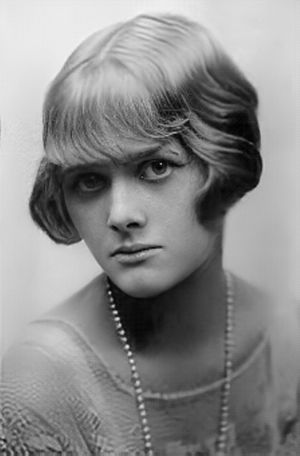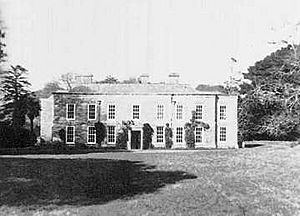Daphne du Maurier facts for kids
Quick facts for kids
Daphne du Maurier
|
|
|---|---|

du Maurier c. 1930
|
|
| Born | 13 May 1907 London, England |
| Died | 19 April 1989 (aged 81) Cornwall, England |
| Occupation | Novelist and playwright |
| Period | 1931–1989 |
| Genre | Literary fiction, thriller |
| Notable works |
|
| Notable awards | National Book Award (U.S.) |
| Spouse |
Lt.-Gen. Sir Frederick Browning
(m. 1932; |
| Children | 3 |
| Parents |
|
| Relatives |
|
|
|
|
Dame Daphne du Maurier (born 13 May 1907, died 19 April 1989) was a famous English writer. She wrote many novels, short stories, and plays. Her parents were well-known actors, and her grandfather, George du Maurier, was also a writer and cartoonist.
Daphne du Maurier is known for her exciting and mysterious stories. Many of her books have been made into popular films, like Rebecca, Frenchman's Creek, and My Cousin Rachel. Her short stories, "The Birds" and "Don't Look Now", also became famous movies. She spent most of her life in Cornwall, England, and many of her stories are set there.
Contents
Biography
Early Life and Family
Daphne du Maurier was born in London. She was the middle of three daughters. Her father, Sir Gerald du Maurier, was a famous actor and theatre manager. Her mother, Muriel Beaumont, was an actress. Her grandfather, George du Maurier, wrote the novel Trilby. Her aunt, Sylvia Llewelyn Davies, was the mother of the boys who inspired J. M. Barrie's Peter Pan; or, The Boy Who Wouldn't Grow Up.
Growing up, Daphne met many famous actors because of her father's work. She spent her childhood at the family's home in London and enjoyed summers in Fowey, Cornwall. Cornwall later became a very important place in her books.
Personal Life

In 1932, Daphne du Maurier married Frederick "Boy" Browning, who later became a Lieutenant-General. They had three children:
- Tessa (born 1933)
- Flavia (born 1937)
- Christian (born 1940)
Daphne was very dedicated to her writing. Sometimes, she was so focused on her stories that she seemed distant to her children. After her husband passed away in 1965, she moved to Kilmarth, near Par, Cornwall. This new home inspired her novel The House on the Strand.
Even though she became very famous, Daphne du Maurier preferred a private life and rarely gave interviews. However, people who knew her well remembered her as a warm and funny person. She enjoyed hosting guests at Menabilly, a house in Cornwall that she leased for many years.
In 1977, she was a guest on the BBC Radio show Desert Island Discs. She chose The Collected Works of Jane Austen as her book and whiskey and ginger ale as her luxury item.
In 1969, she was given the title of Dame Commander of the Order of the British Empire. This is a very high honor in the UK. However, she was very humble and didn't even tell her children about it. They found out from the newspapers! She accepted the award for her grandchildren but avoided the press afterward.
Death
Daphne du Maurier passed away from heart failure in her sleep on 19 April 1989, at the age of 81. She died at her home in Par, Cornwall, the place that had inspired so many of her books. Her body was cremated privately, and her ashes were scattered off the cliffs near Kilmarth and Menabilly in Cornwall, as she had wished.
Writing Career
Novels, Short Stories, and Biographies
Daphne du Maurier's family connections helped her start her writing career. Her first novel, The Loving Spirit, was published in 1931.
Her novel Rebecca (1938) became one of her most successful books. It was an instant hit, selling millions of copies and remaining in print ever since. In the United States, it won the National Book Award for favorite novel in 1938. In the UK, it was voted number 14 in the BBC's "nation's best-loved novels" survey in 2003.
Other important novels include Jamaica Inn, Frenchman's Creek, My Cousin Rachel, and The House on the Strand. Many of her stories, like The King's General, are set in Cornwall and often feature historical events.
Daphne du Maurier was sometimes called a "romantic novelist," but she didn't like this term. Her stories often have mysterious or dark endings, and sometimes include hints of the paranormal. She admired writers who wrote "sensation novels," which were exciting and suspenseful. One critic said that du Maurier wanted her stories to "haunt us beyond their endings."
Her novel Mary Anne (1954) tells a fictional story about her great-great-grandmother, Mary Anne Clarke. This ancestor was connected to Frederick Augustus, Duke of York and Albany, a son of King George III. Her last novel, Rule Britannia, makes fun of how some British people felt about increasing American influence in the UK.
Du Maurier's short stories are often even darker and more thrilling. "The Birds", "Don't Look Now", and "The Blue Lenses" are examples of her scary and surprising tales. In 2011, some of her forgotten short stories, written when she was 21, were discovered. One of them, "The Doll," is about a young woman's unusual obsession with a doll. Her son said it was "quite ahead of its time."
Later in her life, she also wrote non-fiction books, including biographies. She wrote a biography of her father, called Gerald. The Glass-Blowers tells the story of her French ancestors during the French Revolution. The du Mauriers describes her family's move from France to England.
Film Adaptations
Many of Daphne du Maurier's books have been made into films. Rebecca was famously adapted by Alfred Hitchcock in 1940. Other novels like Jamaica Inn, Frenchman's Creek, and My Cousin Rachel also became movies. Hitchcock's film The Birds (1963) and Don't Look Now (1973) were based on her short stories.
Daphne du Maurier often said that the only film adaptations she truly liked were Hitchcock's Rebecca and Nicolas Roeg's Don't Look Now. She sometimes felt that her stories were changed too much for the screen. For example, she didn't like how the ending of Jamaica Inn was changed.
Playwright
Daphne du Maurier also wrote three plays. Her first play was an adaptation of her own novel, Rebecca. It opened in London in 1940 and was very popular, running for many performances.
In 1943, she wrote The Years Between. This play was inspired by her own life and was about a soldier who was thought to have died but then returns home. It was also a big hit in London.
Her third play, September Tide, opened in 1948. It tells the story of a middle-aged woman whose son-in-law falls in love with her.
Accusations of Plagiarism
Sometimes, other writers or critics felt that Daphne du Maurier's work was too similar to their own.
After Rebecca was published, a Brazilian writer named Carolina Nabuco said that du Maurier's book was very similar to her 1934 novel, A Sucessora (The Successor). Nabuco and her editor pointed out that not only the main story but also some situations and conversations were alike. Du Maurier and her publisher denied copying the book, saying that the story ideas were common.
Another writer, Frank Baker, believed that du Maurier had copied his novel The Birds (1936) for her short story "The Birds" (1952). At the time, du Maurier worked for Baker's publisher. When Hitchcock's film The Birds came out, based on du Maurier's story, Baker thought about taking legal action but was advised not to.
See also
 In Spanish: Daphne du Maurier para niños
In Spanish: Daphne du Maurier para niños
- The Queen's Book of the Red Cross
- Category:Novels by Daphne du Maurier
- Maroon beret – She was said to have chosen the colour which is now an international symbol of airborne forces, however in a letter, kept by the British Airborne Assault Archive, she wrote that it was untrue.


